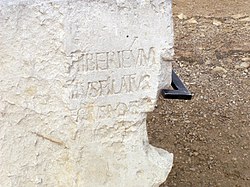User:Ret.Prof/sandbox4
PILATE STONE (draft)
The Pilate Stone is the name given to a block of limestone with a carved inscription attributed to Pontius Pilate, a prefect of the Roman-controlled province of Judaea from 26-36. [1] The stone was found in 1961 by a team of Italian archeologists and is deemed important because Pilate's biographical details had been unclear and some Biblical scholars had believed that he was a mythical character. The find added credence to the historicity of Josephus on Jesus and the Canonical gospels. [2]
Inscription
[edit]
| Item | Description | |
|---|---|---|
| Language: | Latin | |
| Medium: | limestone | |
| Size: | 82 centimeters high, 65 centimeters wide | |
| Length: | 4 lines of writing | |
| Genre: | Building Dedication | |
| Dedicator: | Pontius Pilate | |
| Title: | Praefect of Judea | |
| Approximate Date: | 26–36 CE | |
| Place of Discovery: | Caesarea, Israel | |
| Date of Discovery: | 1961 | |
| Current Location: | Israel Museum | |
| Inventory number: | AE 1963 no. 104 | |
| Chief Excavator: | Antonio Frova | |
| Significance | Historicity of Gospels |
The 82 cm x 65 cm limestone block, was found in 1961 in an excavation of an ancient theater (built by decree of Herod the Great c. 30 BC), called Caesarea Maritima in the present-day city of Caesarea-on-the-Sea. On the partially damaged block is a dedication to Tiberius Caesar Augustus. It has been deemed authentic because it was discovered in the coastal town of Caesarea, which was the capital of Iudaea Province [3] during the time Pontius Pilate was Roman governor.
The partial inscription reads (conjectural letters in brackets):
- [DIS AUGUSTI]S TIBERIEUM [PO]NTIUS PILATUS
- [PRAEF]ECTUS IUDA[EA]E [FECIT D]E[DICAVIT]
The translation from Latin to English for the inscription reads: Pontius Pilate, prefect of Judea, has restored the Tiberieum of the Seaman (or possibly, of the Caesareans) . [4] [5]
Historicity
[edit]Most scholars questioned the actual existence of a Roman Governor with the name Pontius Pilate, the procurator who ordered Jesus' crucifixion. Similarly they questioned the historical reliability of the Gospels. However in June 1961, Italian archaeologists led by Dr. Antonio Frova were excavating an ancient Roman amphitheater near Caesarea-on-the-Sea (Maritima). They uncovered a limestone block. On the face is an engraved inscription which is part of a larger dedication to Tiberius Caesar which clearly says that it was from "Pontius Pilate, Prefect of Judea." This was a significant development in the quest for the historical Jesus, as scholars have confirmed the inscription to be authentic. [6]
Pilate
[edit]Pilate also maintained a residence at Antonia Fortress in Jerusalem,[7] but, outside of his annual trek to oversee the Passover celebration, he seldom visited Jerusalem. During Passover, Jerusalem's population swelled and the possibility of outbreaks of violence increased. Pilate's presence was to quell a rebellion before it started. [8] Keeping the peace was of vital importance not only to Pontius Pilate, but to Yhosef Bar Kayafa (Joseph son of Caiaphas), the high priest of Jerusalem's Jewish ruling council, the Sanhedrin. Caiaphas had been appointed high priest by Pilate's predecessor, Valerius Gratus c. 18, and Pilate retained him.
The two men likely despised each other, but a rebellion would have done neither man any good. Indeed Pilate and Caiaphas enjoyed relatively lengthy and peaceful terms in office. It is probable that Pilate occupied himself with major projects, such as the renovation of the harbor at Caesarea while Caiaphas dealt with local issues.
The Pilate Stone is the only universally accepted archaeological find with an inscription mentioning the name "Pontius Pilatus". It is currently located at the Israel Museum in Jerusalem. [9] [10] [11]
References
[edit]- ^ Robert Van Voorst, Jesus Outside the New Testament: An Introduction to the Ancient Evidence Studying the Historical Jesus, Wm. B. Eerdmans Publishing, 2000. p 47
- ^ Craig A. Evans, Jesus and the ossuaries, Volume 44, Baylor University Press, 2003. pp 45-47
- ^ A History of the Jewish People, H.H. Ben-Sasson editor, 1976, page 247: "When Judea was converted into a Roman province [in 6 CE, page 246], Jerusalem ceased to be the administrative capital of the country. The Romans moved the governmental residence and military headquarters to Caesarea. The centre of government was thus removed from Jerusalem, and the administration became increasingly based on inhabitants of the hellenistic cities (Sebaste, Caesarea and others)."
- ^ James H. Charlesworth, Jesus and Archaeology, Wm. B. Eerdmans Publishing, 2006. pp 334-335
- ^ Craig A. Evans, The Bible knowledge background commentary, Volume 3, Cook Publishing, 2005. p 151
- ^ James H. Charlesworth, Jesus and Archaeology, Wm. B. Eerdmans Publishing, 2006. pp 335-336
- ^ Yigael Yadin, Jerusalem revealed: archaeology in the Holy City, 1968-1974, University Press, 1975. p 87
- ^ J. R. Porter, The Illustrated Guide to the Bible, Oxford University Press US, 1998. p 200
- ^ Jerry Vardaman, A New Inscription Which Mentions Pilate as 'Prefect' , Journal of Biblical Literature Vol. 81, 1962. pp 70-71.
- ^ Craig A. Evans, Jesus and the ossuaries, Volume 44, Baylor University Press, 2003. pp 45-47
- ^ James H. Charlesworth, Jesus and Archaeology, Wm. B. Eerdmans Publishing, 2006. pp 336-337
